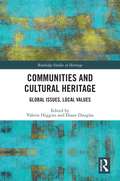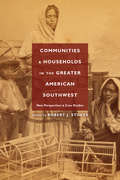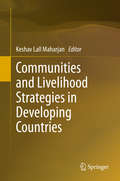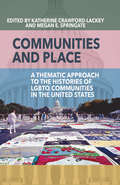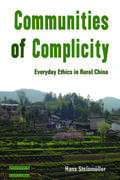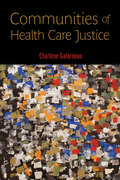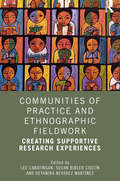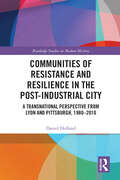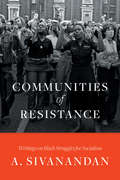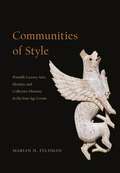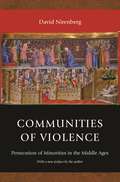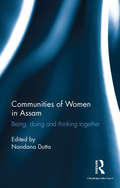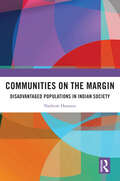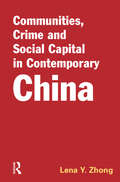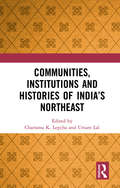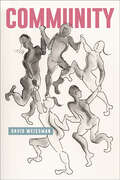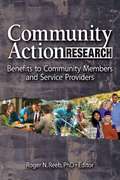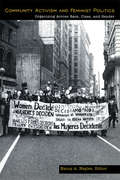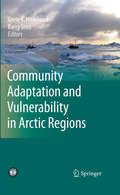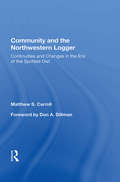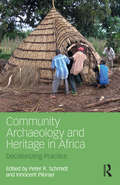- Table View
- List View
Communities and Cultural Heritage: Global Issues, Local Values
by Valerie HigginsCommunities and Cultural Heritage explores the relationship between communities, their cultural heritage and the global forces that control most of the world’s wealth and resources in today’s world. Bringing together scholars and heritage practitioners from nine countries, this book contributes to the ongoing dialogue on community heritage by analysing impediments to full community participation. The underminin of local communities comes at a high price. As the chapters in this book demonstrate, the knowledge embedded within traditional and Indigenous heritage creates communities that are more resilient to environmental and social stressors and more responsive to contemporary challenges such as climate change, environmental degradation, post-disaster recovery and relocation. Cultural heritage practices often fail to capitalise upon local knowledge and traditional skills and undervalue the potential contribution of local communities in finding creative and resourceful solutions to the issues they are confronting. Arguing that the creation of successful community heritage project requires ongoing reflection on the aims, methods, financing and acceptable outcomes of projects, the volume also demonstrates that the decolonization of Western-focussed heritage practices is an ongoing process, by which subaltern groups are brought forward and given a space in the heritage narrative. Reflecting on trends that impact communities and heritage sites across different geographical regions, Communities and Cultural Heritage will be of interest to academics, students and practitioners of cultural heritage,archaeology and anthropology around the world.
Communities and Households in the Greater American Southwest: New Perspectives and Case Studies
by Robert J. StokesCommunities and Households in the Greater American Southwest presents new research on human organization in the American Southwest, examining families, households, and communities in the Ancestral Puebloan, Mogollon, and Hohokam major cultural areas, as well as the Fremont, Jornada Mogollon, and Lipan Apache areas, from the time of earliest habitation to the twenty-first century. Using historical data, dialectic approaches, problem-oriented and data-driven analysis, and ethnographic and gender studies methodologies, the contributors offer diverse interpretations of what constitutes a site, village, and community; how families and households organized their domestic space; and how this organization has influenced researchers’ interpretations of spatially derived archaeological data. Today’s archaeologists and anthropologists understand that communities operate as a multi-level, -organizational, -contextual, and -referential human creation, which informs their understanding of how people actively negotiate their way through and around community constraints. The chapters in this book creatively examine these interactions, revealing the dynamic nature of ancient and modern groups in the American Southwest. The book has two broad complementary themes: one focusing on household decision-making, identity, and structural relations with the greater community; the other concerned with community organization and integration, household roles within the community, and changes in community organization—violence and destabilization, coalescence and cooperation—over time. Communities and Households in the Greater American Southwest weaves a rich tapestry of ancient and modern life through innovative approaches that will be of interest not only to Southwestern archaeologists but to all researchers and students interested in social organization at the household and community levels. Contributors: James R. Allison, Andrew Duff, Lindsay Johansson, Michael Lindeman, Myles Miller, James Potter, Alison E. Rautman, J. Jefferson Reid, Katie Richards, Oscar Rodriguez, Barbara Roth, Kristin Safi, Deni Seymour, Robert J. Stokes, Richard K. Talbot, Scott Ure, Henry Wallace, Stephanie M. Whittlesey
Communities and Livelihood Strategies in Developing Countries
by Keshav Lall MaharjanSustainability of rural communities is threatened by a plethora of factors including climate change and disasters which interact in an intricate manner in making rural people vulnerable and poor. This book is the output of empirical research on communities and livelihood strategies in developing countries. It reveals how rural communities are functioning and earning their livelihoods by making the best use of the resources, local/internal or external/new and the combination of the two to counteract the various challenges they face, with the ultimate goal of becoming resilient to local or global shocks and sustaining that resilience. Local governance is identified as crucial in ensuring sustainable livelihoods as it ensures healthy collaboration between communities, on the one hand and civil society and those communities, on the other hand, in promoting self-sustaining development trajectories. Similarly, the role of social capital is not ignored as it brings in community drive and a sense of purpose, direction and solidarity among community members which facilitates problem solving in periods of crises and disasters.
Communities and Place: A Thematic Approach to the Histories of LGBTQ Communities in the United States
by Katherine Crawford-Lackey and Megan E. SpringateLesbian, gay, bisexual, transgender, and queer (LGBTQ) people have established gathering spaces to find acceptance, form social networks, and unify to resist oppression. Framing the emergence of queer enclaves in reference to place, this volume explores the physical and symbolic spaces of LGBTQ Americans. Authors provide an overview of the concept of “place” and its role in informing identity formation and community building. The book also includes interactive project prompts, providing opportunities to practically apply topics and theories discussed in the chapters.
Communities and Place: A Thematic Approach to the Histories of LGBTQ Communities in the United States
by Katherine Crawford-Lackey and Megan E. SpringateLesbian, gay, bisexual, transgender, and queer (LGBTQ) people have established gathering spaces to find acceptance, form social networks, and unify to resist oppression. Framing the emergence of queer enclaves in reference to place, this volume explores the physical and symbolic spaces of LGBTQ Americans. Authors provide an overview of the concept of “place” and its role in informing identity formation and community building. The book also includes interactive project prompts, providing opportunities to practically apply topics and theories discussed in the chapters.
Communities of Complicity: Everyday Ethics in Rural China
by SteinmEveryday life in contemporary rural China is characterized by an increased sense of moral challenge and uncertainty. Ordinary people often find themselves caught between the moral frameworks of capitalism, Maoism and the Chinese tradition. This ethnographic study of the village of Zhongba (in Hubei Province, central China) is an attempt to grasp the ethical reflexivity of everyday life in rural China. Drawing on descriptions of village life, interspersed with targeted theoretical analyses, the author examines how ordinary people construct their own senses of their lives and their futures in everyday activities: building houses, working, celebrating marriages and funerals, gambling and dealing with local government. The villagers confront moral uncertainty; they creatively harmonize public discourse and local practice; and sometimes they resolve incoherence and unease through the use of irony. In so doing, they perform everyday ethics and re-create transient moral communities at a time of massive social dislocation.
Communities of Health Care Justice
by Charlene GalarneauThe factions debating health care reform in the United States have gravitated toward one of two positions: that just health care is an individual responsibility or that it must be regarded as a national concern. Both arguments overlook a third possibility: that justice in health care is multilayered and requires the participation of multiple and diverse communities. Communities of Health Care Justice makes a powerful ethical argument for treating communities as critical moral actors that play key roles in defining and upholding just health policy. Drawing together the key community dimensions of health care, and demonstrating their neglect in most prominent theories of health care justice, Charlene Galarneau postulates the ethical norms of community justice. In the process, she proposes that while the subnational communities of health care justice are defined by shared place, including those bound by culture, religion, gender, and race that together they define justice. As she constructs her innovative theorization of health care justice, Galarneau also reveals its firm grounding in the work of real-world health policy and community advocates. Communities of Health Care Justice not only strives to imagine a new framework of just health care, but also to show how elements of this framework exist in current health policy, and to outline the systemic, conceptual, and structural changes required to put these justice norms into fuller practice.
Communities of Ludlow: Collaborative Stewardship and the Ludlow Centennial Commemoration Commission
by Fawn-Amber Montoya Karin LarkinFor more than one hundred years, people have come to the Ludlow Massacre Memorial site to remember the dead, to place themselves within a larger narrative of labor history, and to learn about what occurred there. Communities of Ludlow reveals the perseverance, memory, and work that has been done to enrich and share the narratives of the people of Ludlow and the experiences of those who commemorate it. The history of the Ludlow Massacre encompasses the stories of immigrant groups, women, the working-class, and people of color as much as the story of that tragedy, and the continued relevance of these issues creates a need for remembrance and discussion of how to make the events of the Ludlow Massacre available to contemporary society. The book outlines recent efforts to remember and commemorate this important historical event, documenting the unique collaborations in public scholarship and outreach among the diverse group of people involved in marking the 100-year anniversary of the Ludlow Massacre. The chapters relate the tales of the stewards of the Ludlow Massacre—the various communities that rallied together to keep this history alive and show its relevance, including lineal descendants, members of the United Mine Workers of America, historians, archaeologists, scholars, artists, interpreters, authors, playwrights, and politicians. The book also offers tips, strategies, and cautionary tales for practicing engaged public scholarship. The history of the Ludlow Massacre has been told as a tragedy of striking miners in the West that occurred during a turbulent time in US labor relations, but it is so much more than that. Communities of Ludlow explores the intersections of public scholarship, advocacy, and personal experience, weaving these perspectives together with models for practicing public scholarship to illustrate the power of creating spaces for sharing ideas and information in an environment that encourages creativity, open dialogue, public outreach, political action, and alternative narratives. Contributors: Robert Butero, Robin Henry, Michael Jacobson, Elizabeth Jameson, Linda Linville, Matthew Maher, Yolanda Romero
Communities of Practice and Ethnographic Fieldwork: Creating Supportive Research Experiences
by Susan Bibler Coutin Lee Cabatingan Deyanira Nevárez MartínezCommunities of Practice and Ethnographic Fieldwork offers a new perspective on how ethnography might be learned in real time through participation in a supportive community of practice.It draws on the experiences, knowledge, and training of an interdisciplinary group of scholars who have studied legal topics ethnographically alongside and with the support of fellow ethnographers at varying stages of their careers. Contributors address topics that are of interest to those who teach ethnography as well as to those who are learning this approach. Such topics include ethics, positionality in the field, the combination of personal and professional circumstances, and the process and pain of changing research topics. Each chapter emphasizes the role of mentoring and collective problem-solving through a lab model of fieldwork practice, particularly when carrying out research with subjects and interlocutors who may have undergone trauma.Written by a diverse group of scholars, this volume will appeal especially to Black, Indigenous, and People of Color, and female-identifying ethnographers in a range of fields. It provides a framework for how fieldwork can continue moving forward even in the most challenging of times and will be of particular interest to scholars in anthropology, sociology, law, urban planning/studies, geography, political science, ethnic studies, public policy, sociolegal studies, and education.
Communities of Resistance and Resilience in the Post-Industrial City: A Transnational Perspective from Lyon and Pittsburgh, 1980–2010 (Routledge Studies in Modern History)
by Daniel HollandThis book is about the grassroots community revitalization movement in Pittsburgh, Pennsylvania, and Lyon, France, between 1980 and 2010, an extension of the post-WWII civil rights campaign that is rarely considered.It tells the story of residents' attempts to improve their communities through social capital or people power. In positive ways, citizens created vibrant, attractive neighborhoods. But their actions also generated unintended consequences, such as high real estate prices and minority displacement that threatened to unravel their hard work. Communities of Resistance and Resilience is an ethnographic survey that relies on oral histories, archival research, on-the-ground site surveys, and the author’s personal experience as a neighborhood reinvestment practitioner for more than 30 years. It brings to life stories that would otherwise remain obscured, such as the lingering impact of the March for Equality and Against Racism, organized in Lyon in 1983, and the formation of the Pittsburgh Community Reinvestment Group in Pittsburgh in 1988, both of which launched national movements.This is of great use to scholars of transatlantic history as well as a general audience interested in modern social movements in the United States and France.
Communities of Resistance: Writings on Black Struggles for Socialism
by A. Sivanandan&‘There is no socialism after liberation, socialism is the process through which liberation is won.&’ Each of the essays in Communities of Resistance acts as a critical reaffirmation of socialist politics as the context for questions of race and resistance.The left itself is under scrutiny here—from a black perspective. A series of powerful interventions covers many of the issues which have confronted radical politics in the 1980s: inner-city uprisings, the demand for black sections in the Labour Party, local government anti-racism, the move to a common European market. This collection included incisive critiques of contemporary Marxism (&‘All that Melts into Air is Solid: The Hokum of &“New Times&” &’), of post-colonial development, and of the Eurocentric assessment of imperialism.
Communities of Style: Portable Luxury Arts, Identity, and Collective Memory in the Iron Age Levant
by Marian H. Feldman"Communities of Style"aexamines the production and circulation of portable luxury goods throughout the Levant in the early Iron Age (1200OCo600 BCE). In particular it focuses on how societies in flux came together around the material effects of art and style, and their role in collective memory. Marian H. Feldman brings her dual training as an art historian and an archaeologist to bear on the networks that were essential to the movement and trade of luxury goodsOCoparticularly ivories and metal worksOCoand how they were also central to community formation. The interest in, and relationships to, these art objects, Feldman shows, led to wide-ranging interactions and transformations both within and between communities. Ultimately, she argues, the production and movement of luxury goods in the period demands a rethinking of our very geo-cultural conception of the Levant, as well as its influence beyond what have traditionally been thought of as its borders. "
Communities of Violence: Persecution of Minorities in the Middle Ages - Updated Edition
by David NirenbergIn the wake of modern genocide, we tend to think of violence against minorities as a sign of intolerance, or, even worse, a prelude to extermination. Violence in the Middle Ages, however, functioned differently, according to David Nirenberg. In this provocative book, he focuses on specific attacks against minorities in fourteenth-century France and the Crown of Aragon (Aragon, Catalonia, and Valencia). He argues that these attacks--ranging from massacres to verbal assaults against Jews, Muslims, lepers, and prostitutes--were often perpetrated not by irrational masses laboring under inherited ideologies and prejudices, but by groups that manipulated and reshaped the available discourses on minorities. Nirenberg shows that their use of violence expressed complex beliefs about topics as diverse as divine history, kinship, sex, money, and disease, and that their actions were frequently contested by competing groups within their own society. Nirenberg's readings of archival and literary sources demonstrates how violence set the terms and limits of coexistence for medieval minorities. The particular and contingent nature of this coexistence is underscored by the book's juxtapositions--some systematic (for example, that of the Crown of Aragon with France, Jew with Muslim, medieval with modern), and some suggestive (such as African ritual rebellion with Catalan riots). Throughout, the book questions the applicability of dichotomies like tolerance versus intolerance to the Middle Ages, and suggests the limitations of those analyses that look for the origins of modern European persecutory violence in the medieval past.
Communities of Women in Assam: Being, doing and thinking together
by Nandana DuttaThis book uses communities of women as a framework for reading women’s experience, rights and aspirations in Assam and Northeast India. It explores the varying roles played by such communities in the formation of society, the emergence of a women’s public sphere and the representation of these communities in culture. The essays in the volume study a host of women’s communities including the Mahila Samiti, Jain women’s organisations, Lekhika Sanstha, lesbian communities, religious gatherings, scientific and environmental groups, women’s collaborations through cookbooks, as well as nebulous communities of victims of persecution. They examine how women’s communities are both empowering and transformational but may paradoxically also be regressive and static. Lucid, analytical, and rich with case studies, this volume will be useful to scholars and researchers of gender studies, sociology, political science, history and cultural studies, particularly those interested in Northeast India.
Communities on the Margin: Disadvantaged Populations in Indian Society
by Saiyed Nadeemul HasnainThis book probes into the marginalized communities of the Indian society through historical and contemporary societal perspectives. It discusses socio-cultural aspects of the experiences of Scheduled Castes, Dalits, Scheduled Tribes/tribal communities, Other Backward Classes, linguistic minorities, religious minorities and the queer/LGBT as sexual minorities.Adopting an inter-disciplinary approach, it looks at all these segments of Indian society through historical and societal perspectives. Divided into three broad sections – Scheduled Castes, Scheduled Tribes, and minorities, this book provides historical perspective backed by the contemporary situation and emerging social changes among these communities. Written in a lucid manner, the book aims to reach and impact readers without having any prior academic exposure to this subject area.This book would be useful to the students, researchers and teachers of sociology, social work, history, economics, political science, and other interdisciplinary courses in social sciences. The book will also be valuable reading for those interested in South Asian studies, especially contemporary Indian society.
Communities, Crime and Social Capital in Contemporary China
by Lena ZhongThis book explores the theoretical and empirical dimensions of community crime prevention in China, examining in particular the role of social capital in a rapidly modernizing economic, social and political context. In doing so it provides a vivid picture of contemporary crime and crime control in China as well as analyzing the very particular Chinese approach to community crime prevention, looking at such social institutions as the household registration system, the neighbourhood committee, the work unit and the public security bureau.The particular focus of this book is on BLSCC − Building Little Safe and Civilized Communities − in the city of Shenshen which has been undergoing rapid change. The book looks at two contrasting communities within the city, looking at their different characteristics and the differing ways in which social capital operates in relation to crime and crime prevention.As well as shedding light on the hitherto largely hidden subject of crime prevention in China this book also makes an important contribution to wider debates about social capital and its potential, an invaluable study based on unique research.
Communities, Institutions and Histories of India’s Northeast
by Charisma K. Lepcha Uttam LalPeople from India’s Northeast have crafted distinct as well as diverse cultural cryptograms, discernments and personality which is frequently at loggerheads with the power politics from outside the region. Thus, attention is often on the societies of the Northeast India as they putter with transforming institutions and more intensive resource consumption in the wake of modernization and development activities. This volume is an examination into questions of who exercises control, who constructs knowledge/ideas about the region and how far such discourses are people-centric. It inspects how India’s Northeast have been understood in colonial and post-colonial contexts through the contributions from research scholars and faculties from different academic spaces. These contributions are both from within the region as well as from neighbourhood. Thus, presenting a cross-dimensional gaze on social, political, economic as well as issues related to space-relation. Please note: Taylor & Francis does not sell or distribute the Hardback in India, Pakistan, Nepal, Bhutan, Bangladesh and Sri Lanka.
Communities, Networks and Ethnic Politics (Routledge Revivals)
by Ken HahloFirst Published in 1998, this study explores ethnic community political participation in local politics in the North West British town. The analysis is located within the framework of the shift from Fordism to post-Fordism.From 1965 to 1980 ethnic communities increased their access to scarce resources including political influence by engaging in ethnic politics. Using membership of religious organisations as structures of support, elected men deployed ethnic identities to compete with others for ethnic support and influence over local decision-making processes. This gave ethnic minorities a positive role in local politics. With the support of local community relations councils (CRCs), ethnic politics flourished. It gave ethnic communities real opportunities to participate as ethnic communities in politics. Using local events, ethnic leaders competed for political influence and ethnic support. After 1977 the shift from Fordism to post-Fordism brought about a decline in ethnic political participation. While conferment of citizenship secured their right to stay in Britain, the rise in consumerism undermined the manufacturing sector on which they depended for work. With no ethnic political identity, today, these communities are again politically disadvantaged.
Community
by David WeissmanCommunities are vital to personal and social well-being because collaboration is required where skills and resources are scarce; their pathologies—anonymity and isolation, tribalism and murder—defeat us.Community is often invoked respectfully but without a clear referent. The word is said to be used ninety-four ways, evidence that its sense is diffuse. Community clarifies the word's principal expressions and the alternative ideological spaces-holistic and hierarchical or open and tolerant-in which communities form. Members bind in the interest of utility-jobs or schools-or because home and friendship are the focus of feeling and significance. These binders are social glue: they explain our dedication to communal aims and loyalty to fellow members. Autonomy in their context is socialized; its bases are the information, attitudes, and skills acquired when families and schools prepare us for roles in communities inherited or chosen. Yet community is fraught. Holistic societies are repressive; open societies are vulnerable. The members of successful communities-families, businesses, and schools-often thrive. Those excluded for want of luck or skill are abandoned and anonymous. Their isolation is one of an open society's two pathologies: collaboration is a social necessity when resources, space, and skills are scarce; competition turned visceral and murderous is a vice.
Community Action Research: Benefits to Community Members and Service Providers
by Roger N. ReebDiscover how to better help those in your community in need of servicesCommunity Action Research comprehensively explores models for community action research, incorporating quantitative and qualitative research to highlight the advantages to community members as well as the volunteers/paraprofessionals who implement the services. Respected experts present the latest research on the fulfillment of the needs of community members as well as the benefits to the volunteers and paraprofessionals, including psychological empowerment, psychological sense of community, and other facets of personal development.Community Action Research is helpfully organized into two sections. The first section presents a sample of empirical studies that examines whether community action research demonstrated benefits for community members. The second section provides empirical studies that show the positive impact of community action research on the personal development of volunteers and paraprofessionals who provided the research-related services. This detailed text is carefully referenced and uses several tables to enhance understanding of research data. Community Action Research discusses: the Adolescent Diversion Project as an alternative to juvenile court home-based behavior modification programs for autistic children the People Awakening Project and the role paraprofessionals played in Alaska Native sobriety a crime prevention project launched by a residential neighborhood association the Actual Community Empowerment Reading Program which utilized community members as literacy tutors the Community Service Self-Efficacy Scale&’s reliability and validity the Hawaiian Studies Program&’s weekly participation in community service-learning exercises and more!Community Action Research is insightful reading for psychologists, sociologists, social workers, criminal justice researchers and professionals, community counselors, practitioners and researchers in community prevention and intervention, clinical supervisors, service learning specialists, educators, students, and mental health and human services program administrators, planners, or evaluators.
Community Activism and Feminist Politics: Organizing Across Race, Class, and Gender (Perspectives on Gender)
by Nancy NaplesThis collection demonstrates the diversity of women's struggles against problems such as racism, violence, homophobia, focusing on the complex ways that gender, culture, race-ethnicity and class shape women's political consciousness in the US.
Community Adaptation and Vulnerability in Arctic Regions: Framework Document For An International Polar Year Consortium
by Barry Smit Grete K. HovelsrudUnder the auspices of International Polar Year (IPY), the CAVIAR consortium was formed with partners from all eight Arctic countries. The aim of the interdisciplinary CAVIAR project is to increase understanding of the vulnerability of Arctic communities to changing environmental conditions, including climate change, and to contribute to the development of adaptive strategies and policies. In partnership with local collaborators in over two dozen communities, researchers have documented the conditions and forces that contribute to vulnerabilities, identified adaptive strategies and attempted to assess the prospects for adaptation in the future.
Community And The Northwestern Logger: Continuities And Changes In The Era Of The Spotted Owl
by Matthew S. CarrollIt has often been said that natural resource and environmental problems cannot be solved without solving human problems. In this book, Matthew Carroll examines the economic and social circumstances of northwestern U.S. loggers in the face of shifts in environmental politics, dramatic reductions in timber harvest levels on federal lands, and changing technology and market forces—among other factors that are rapidly transforming their industry, their livelihoods, and their communities. Drawing upon sociological fieldwork in logging communities that he conducted at various times over a period of nearly a decade and using the spotted owl-old growth controversy as a case study, Carroll provides a rich and detailed picture of life among northwestern loggers. He lays out the human dimensions and dilemmas of the timber crisis. Expanding it from the oversimplified owl-versus- logger confrontation, he puts these issues in a historical and policy context and suggests parallels to other controversies such as public grazing and federal or state river protection. Carrol’s work revives the concept of occupational community and shows ways it can be used to understand the dynamics of rural occupations linked to resource extraction.
Community Archaeology and Heritage in Africa: Decolonizing Practice
by Peter R. Schmidt Innocent PikirayiThis volume provides new insights into the distinctive contributions that community archaeology and heritage make to the decolonization of archaeological practice. Using innovative approaches, the contributors explore important initiatives which have protected and revitalized local heritage, initiatives that involved archaeologists as co-producers rather than leaders. These case studies underline the need completely reshape archaeological practice, engaging local and indigenous communities in regular dialogue and recognizing their distinctive needs, in order to break away from the top-down power relationships that have previously characterized archaeology in Africa. Community Archaeology and Heritage in Africa reflects a determined effort to change how archaeology is taught to future generations. Through community-based participatory approaches, archaeologists and heritage professionals can benefit from shared resources and local knowledge; and by sharing decision-making with members of local communities, archaeological inquiry can enhance their way of life, ameliorate their human rights concerns, and meet their daily needs to build better futures. Exchanging traditional power structures for research design and implementation, the examples outlined in this volume demonstrate the discipline’s exciting capacity to move forward to achieve its potential as a broader, more accessible, and more inclusive field.

